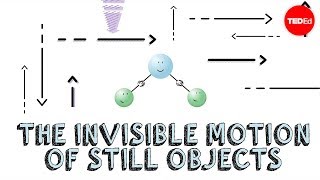(单词翻译:单击)
Many of the inanimate objects around you probably seem perfectly still.
你周围许多物体看似是完全静止的。
But look deep into the atomic structure of any of them, and you'll see a world in constant flux.
但请从微观原子结构上观察它们,你会发现一个永不停息运动着的世界。
Stretching, contracting, springing, jittering, drifting atoms everywhere.
扩张着,压缩着,弹动着,抖动着,原子动来动去。
And though that movement may seem chaotic, it's not random.
即使这种运动看似混乱,它们其实有规律可循。
Atoms that are bonded together, and that describes almost all substances, move according to a set of principles.
原子连接在一起,几乎构成了所有物质,按照一定规律在运动着。
For example, take molecules, atoms held together by covalent bonds.
例如分子中原子有着共价的联系。
There are three basic ways molecules can move: rotation, translation, and vibration.
分子以三种基本规律运动:旋转,平移和振动。
Rotation and translation move a molecule in space while its atoms stay the same distance apart.
旋转和转化时分子在空间中运动,此时原子的间隙不变。
Vibration, on the other hand, changes those distances, actually altering the molecule's shape.
然而振动会改变原子间距,实际上这改变了分子的形状。
For any molecule, you can count up the number of different ways it can move.
每种分子都有一定数量的运动方式。
That corresponds to its degrees of freedom, which in the context of mechanics basically means
运动方式的多少与其自由度有关,用机械术语讲,
the number of variables we need to take into account to understand the full system.
就是我们为了全面了解一个整体而需要考虑的变量的数量。
Three-dimensional space is defined by x, y, and z axes.
立体空间可用x、y、z轴描述。
Translation allows the molecule to move in the direction of any of them.
平移可让分子朝各个方向运动。
That's three degrees of freedom. It can also rotate around any of these three axes.
这种运动方式在三个维度上都完全自由。分子也可以围绕这三个坐标轴旋转。
That's three more, unless it's a linear molecule, like carbon dioxide.
这是另外三种运动方式,除非它是像二氧化碳一样的线型分子。
There, one of the rotations just spins the molecule around its own axis,
线型分子的一种旋转方式是绕自己的轴线旋转,
which doesn't count because it doesn't change the position of the atoms.
由于它的原子位置不变,这种方式不纳入旋转方式的种类。
Vibration is where it gets a bit tricky. Let's take a simple molecule, like hydrogen.
振动就有一些复杂了。以氢分子为例。
The length of the bond that holds the two atoms together is constantly changing as if the atoms were connected by a spring.
它们的两原子间的间隙在不断变化,就像被弹簧连接一样。
That change in distance is tiny, less than a billionth of a meter.
这种间隙的改变很微小,小于十亿分之一米。
The more atoms and bonds a molecule has, the more vibrational modes.
分子的原子越多,它的振动方式就越多。
For example, a water molecule has three atoms: one oxygen and two hydrogens, and two bonds.
例如水分子有三个原子:一个氧原子,两个氢原子和两个相联点。
That gives it three modes of vibration: symmetric stretching, asymmetric stretching, and bending.
这种结构让它有了三种振动方式:对称拉伸,非对称拉伸和弯折。
More complicated molecules have even fancier vibrational modes, like rocking, wagging, and twisting.
更复杂的分子有更剧烈的振动方式,比如强振动,摇摆和弯折。
If you know how many atoms a molecule has, you can count its vibrational modes.
知道了分子中原子的个数,就能知道其振动的种类数量。

Start with the total degrees of freedom, which is three times the number of atoms in the molecule.
当运动不受阻碍时,振动种类数量是原子数量的三倍。
That's because each atom can move in three different directions.
这是因为每个原子都可以从三个方向移动。
Three of the total correspond to translation when all the atoms are going in the same direction.
三种运动种类属于平移,这时所有原子同方向移动。
And three, or two for linear molecules, correspond to rotations.
旋转有三种运动方式,线型分子有两种。
All the rest, 3N-6 or 3N-5 for linear molecules, are vibrations.
其余的3N-6种,线型分子3n-5种,属于振动。
So what's causing all this motion?
那么这些运动由什么引起呢?
Molecules move because they absorb energy from their surroundings,
分子吸收了周围的能量而得以运动,
mainly in the form of heat or electromagnetic radiation.
这些能量主要以热量或电磁波的形式存在。
When this energy gets transferred to the molecules, they vibrate, rotate, or translate faster.
当这些能量转移到分子上时,它们可能振动,可能旋转,或是更快地平移。
Faster motion increases the kinetic energy of the molecules and atoms.
更快的运动速度导致了粒子的动能增大。
We define this as an increase in temperature and thermal energy.
宏观上表现为温度升高,内能增大。
This is the phenomenon your microwave oven uses to heat your food.
微波炉工作正是应用了这一原理。
The oven emits microwave radiation, which is absorbed by the molecules, especially those of water.
微波炉放射出电磁波被分子吸收,尤其易被液体吸收。
They move around faster and faster, bumping into each other and increasing the food's temperature and thermal energy.
分子运动速度加快,相互碰撞后增大了食物温度和内能。
The greenhouse effect is another example.
温室效应则是另外一个例子。
Some of the solar radiation that hits the Earth's surface is reflected back to the atmosphere.
太阳的辐射照射着地球表面,被地表反射到大气层。
Greenhouse gases, like water vapor and carbon dioxide absorb this radiation and speed up.
水蒸气或二氧化碳之类的温室气体将这些辐射吸收,运动速度加快。
These hotter, faster-moving molecules emit infrared radiation in all directions, including back to Earth, warming it.
这些炽热、高速运动的分子朝各个方向释放红外线,有一些红外线回到地球,使之升温。
Does all this molecular motion ever stop?
这种分子运动会停止吗?
You might think that would happen at absolute zero, the coldest possible temperature.
你可能认为在绝对零度时这有可能发生,在可能到达的最低温度下。
No one's ever managed to cool anything down that much,
至今没有人曾创造出那样的低温环境,
but even if we could, molecules would still move due to a quantum mechanical principle called zero-point energy.
但是即使我们可以,根据量子力学的中零点能量的解释,分子在那样的情况下仍能运动。
In other words, everything has been moving since the universe's very first moments,
换句话说,自宇宙婴儿时期以来,万事万物就在不断运动,
and will keep going long, long after we're gone.
在我们消逝幻灭之后仍会继续。


